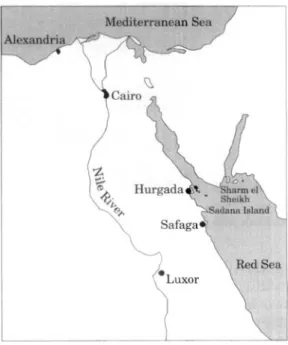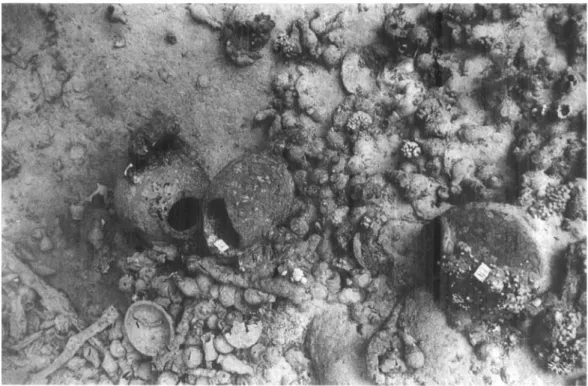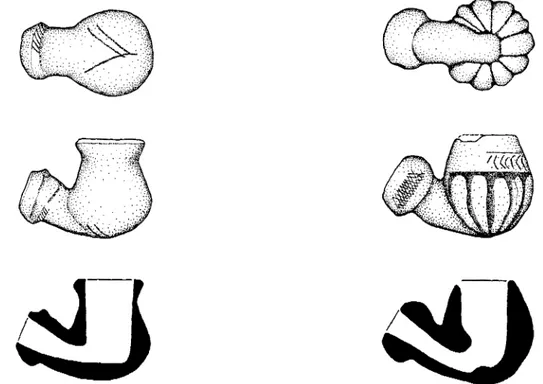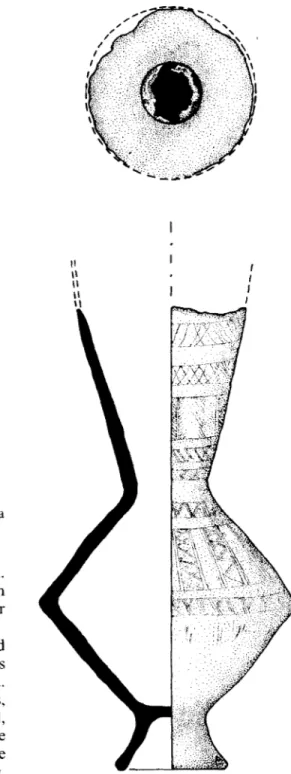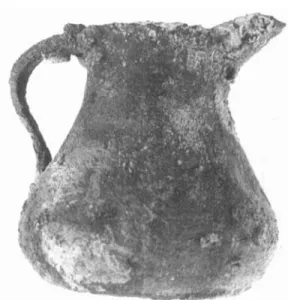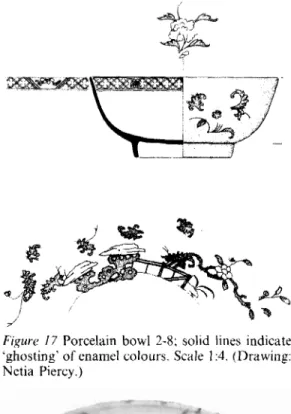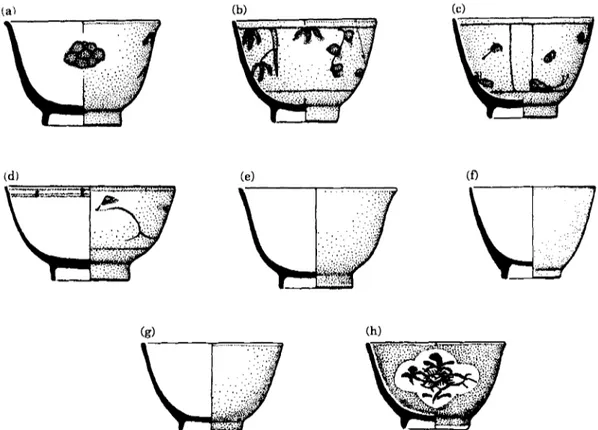The Intrmutionul .lournu1 of Nuutic~ul Archuedog?; (1996) 25.2: 83-94
Sadana Island shipwreck, Egypt: preliminary report
Cheryl
Haldane
Institute of Nuuticul Arrhrrrology --Egypt, P. 0. Box 432. El Ihrahimiu, Alexundriu, E g y p
Introduction
The Sadana Island shipwreck has been known to Red Sea divers for more than ten years, but 1995 saw the first year of sanc- tioned excavation on the site. An INA- EgyptlSupreme Council of Antiquities (SCA) team worked for nine weeks to document the wreck’s current condition and to begin excavating the site.
Located during INA-Egypt‘s 1994 ship- wreck survey. the Sddana Island ship lies in the curve of a fringe reef on Egypt’s east- ern Red Sea coastline (Haldane, 1994). Artefacts, anchors. and ship’s timbers cover an area about 50 x 25 m at a depth of 28 to 40 m. The vessel’s cargo included Chinese porcelain intended for the Middle Eastern market, more than 1000 kulluI
(small clay water vessels), large storage jars (:illn in Arabic) of at least two types, copper wares, and organic products in- cluding coconuts. coffee, peppercorns and an aromatic resin.
The Sharm el Sheikh \hipwreck exca- vated by Arner Kaban may have carried a similar cargo. but only a few porcelain $herds remained amongst many kullul on that site, and few other object types were recovered (Raban. 1971 ). In contrast, more than 300 porcelain artefacts alone were excavated in the first season at Sadana Island. Both \hips date to the decades around AD 1700. a time when historical records for the Red Sea provide little evi- dence for trade north of Jiddah in Saudi Arabia or Quseir. a major entrep6t on Egypt’s coast
1~1’.7~741~/196/0~008~+ 12 518 oo/o
Figure 1 Map to show the location of Sadana Island.
Although the Ottoman Empire had been forced to withdraw from the Indian Ocean, trade in eastern wares at Jiddah and Quseir was brisk during the 17th and 18th cen- turies (Faroqhi, 1994: 488). Indian goods, especially textiles, and coffee from Yemen feature prominently in tax and customs’ records (McGowan, 1994: 731 -732), and Indian ships are known to have carried Chinese porcelain further west. Ships either offloaded at Quseir or Jiddah to avoid the long and difficult northbound journey in the Red Sea or transhipped cargo to Ottoman-controlled Egyptian hulls for the last stage to Suez. At the end 1996 The N a u t i ~ d l Aichneologq Society
NAUTICAL ARCHAEOLOGY, 25.2
Figure 2 View of lower kullal field with zillu BI and K V t o the left of centre. A n anchor fluke lies in
contact with KV to the left. (Photo: Alan Flanigan.)
of the 17th century, a French traveller mentioned that a ra’is or ‘boss’, possessed two Indian ships in Suez; in 1723 Indian ships were used by French merchants to transport grain from Jiddah to Suez (Raymond, 1973: 110). Once goods reached Suez, most were transferred by land to Cairo, and some continued their journey by river boat from Cairo to Alexandria. From Alexandria, Ottoman and European ships sailed throughout the Mediterranean.
The Qing porcelain on the Sadana Island Shipwreck firmly establishes links in a network of waterborne trade stretching from China to Istanbul and beyond, and although it has been about 300 years since its expected arrival, some of the Sadana Island’s cargo has reached Alexandria at last. All finds from the ship are stored in the National Maritime Museum’s new laboratory for treating submerged arte- facts that is a joint effort by the Institute 84
Figure 3 Buff fabric earthenware jar 1-1 with dark
green glazed interior. Shown at a scale of 1.4.
(Drawing: Netia Piercy.)
of Nautical Archaeology-Egypt, and Egypt’s Supreme Council for Antiquities.
Excavation
Our objectives for the season included establishing datum points for trilateration, measuring and moving large objects ob- structing the central portion of the site, and opening test trenches to examine hull
CHERYL HALDANE: SADANA ISLAND SHIPWRECK, EGYPT
Figure 4 Yellow, glazed earthenware bowl 1-5
with brown paint. Scale i:4. (Drawing: Netia
Piercy.)
preservation and construction in different parts of the vessel.
The Sadana Island shipwreck came to rest along the reefs base. A pile of four- armed grapnel anchors marks the bow; these probably were below decks when the ship sank. Further north along the reef edge is a pile of four other grapnel anchors of the same type, but not part of the contiguous wreck-site. The port side rests in sand at the base of the reef, and frames along or near the centreline of the ship mark the area where the starboard side broke away and fell onto the steep sandy slope below 35 m. Frames from the after end of the vessel protrude from the reef in the east end of the site and can be traced along the entire length of the hull. Five and
Figure 5 Porcelain cup with underglaze blue dec-
oration; ht 43 mm. Scale 1:2. (Drawing: Kendra
Burnett.)
six layers of kullul cover an area at least 12 x 7 x 1.2 m in the stern, where another anchor was stored in the bottom of the hull (Fig. 1). Few artefacts remain in the shal- lower port side, and, with the exception of the kullal and zillu, most finds originate downslope of the keel area.
We moved more than 30 d l a in the centre of the site upslope to the base of the reef. Two types were noted, one with a wide mouth and the other with a pro- nounced neck and narrow mouth. Both types are about a metre tall and have a diameter of 0.7 m. Most zillu were partially filled with sand; none were sealed although a wooden plug that may fit the smaller size was recovered. Some of the large jars, however, had been filled with objects by sport divers who had previously told us that they were trying to protect the objects from theft by other sport divers.
Neighbouring zillu Bi and KV, for ex- ample, held a copper handle, a copper tool,
a lidded copper cooking vessel, an earthen- ware jar with glazed interior, a spouted clay jug, two glazed bowls, an earthenware 85
NAGTICAL ARCHAEOLOGY, 25.2
Figure 6 Earthenware pipes: 1-3 from zilla BI and 1-10 from nearby. Scale 1:2. (Drawing: Lara Piercy.)
pipe, small porcelain cup fragment, a unique glass bottle neck, and a round glass bottle base (Figs 1-5). Sixteen porcelain bowls in two stacks so completely en- crusted that only a small portion of a single rim was visible nearly filled zilla EW. Yet another jar stored the most complete example of a glass case bottle found on the site. and others in the shallower portion of the site held earthenware water vessels.
At the same time excavators chiseled
zilh in the midships section free from coral growth, others plotted and raised nearly 140 kulfal from the stern. The large area covered by these water vessels has been greatly disturbed by visitors to the site. Open areas are surrounded by rings of kullul whose original orientation, deter- mined by marine growth, was quite differ- ent. We noted nearly 20 different types of bottles, but most are broadly similar, made
of a greylbrown fabric and decorated with incised and punctuate geometric designs
(Figs 6-9). Almost all of the surface layer of kullul were broken or chipped at the neck or base, but a substantial number of undisturbed bottles below this layer were noted. An estimated 10% of the existing kullal were raised by the team.
Porcelain objects are located in the bottom of the forward third of the hull. The durable and heavy porcelain provided an excellent ballast here, and several stacks of large dishes in their original positions in the ship were raised. Teams working on measuring and excavating porcelain objects dealt with two different types of material: that clearly in context, usually locked to other site features by coral growth or marine encrustation; and porce- lain that had been recently broken and dumped in mixed piles by looters. Far too many of the porcelain objects displayed recent breaks, chips and shattering consist- ent with what was probably incidental destruction by divers using hammers and
CHERYL HALDANE. S A D A N A ISLAND SHIPWRECK, EGYPT
Figure 7 Ku!h 1-6. Scale 1 2 . (Drawing: Kendra Burnett.)
chisels to free porcelain from encrustation. Several concentrations of freshly broken porcelain objects are clearly dumps for undesired fragments.
Copper wares seem to have been loaded or dispersed along most of the vessel's length, again, downslope of the keel area. Ceramic-lined braziers with three legs, ewers, shallow pans, one enormous bowl, deep cooking pots with lids, dishes, a kettle and even a coRee pot are included in the 27 copper objects excavated this year (Fig.
10). In addition. a pulley sheave made of cupreous metal of undetermined composi- tion and a decorated box were recovered rrom the site's surface. Other metal finds include: a single white metal sphere 4 mm
I I I I I I 1
Figure 8 Kulla 1-12. Scale 1.2. (Drawing: Kendra Burnett.)
in diameter that was part of a deposit of organic material in a copper dish; a 87
NAUTICAL ARCHAEOLOGY, 25.2
Figwc. 9 Kullu 1-55. Scale 1:2. (Drawing: Kendra Burnett.)
number of very large iron encrustations noted but not studied this year; and a very few iron fastening encrustations. No weapons of any type were observed.
Organic materials from the 1995 season include: several coconut husks from low in the hull; more than a kilogram of aromatic resin from one of the test trenches in the forward port quarter; coffee beans trapped in an kullu; peppercorns preserved in copper corrosion products inside a cooking pot; coriander and other seeds from a variety of sample locations; and an abun- dance of dunnage and rope, all beautifully preserved in several parts of the site. Worked objects include a small plug for a
1-92
---?
Figure 10 Kulla 1-92. Scale 1.2. (Drawing: Kendra Burnett.)
bottle, what may be a barrel lid (maximum diameter 0.28 m), and a wooden stopper 0.13 m in diameter, all found in the midships area.
Glass objects, primarily green case bottle fragments, are concentrated in a single area in the starboard section just forward of midships and low in the hull. Although
CHERYL HALDANE: SADANA ISLAND SHIPWRECK, EGYPT
Figure I 1 Copper coffee pot 6-18; 195mm. (Photograph: Elizabeth Greene).
fragments came from other parts of the wreck, most seem to have been carried there by previous site visitors. Two dark brown bases with a round section also were recovered this summer.
The porcelain
More than 300 broken or complete porce-
lain artefacts recovered this year originated in the factories of China that prepared wares specifically for export to the Middle Eastern market. Blue-and-white, Chinese Imari polychrome, and monochrome glazed wares all were present. As Rose Kerr of the Victoria and Albert Museum, London, has kindly pointed out, the most striking parallels for the Sadana Island porcelain may be seen in the Topkapi Saray Museum, Istanbul (Krahl
& Ayers, 1986). Some of the object types from the 1995 excavations are described below.
Large blue-and-white dishes decorated with a peony scroll motif comprise nearly half of the porcelain excavated in 1995 (Fig. 11). Four large peonies alternate with four small blooms in a scrolling pattern around a central flower on the interior; the
remaining space is nearly filled with ad- ditional petals and leaves up to a blue band just below the white rim. On the exterior, two bare branches decorate opposite sides of the dishes. Fifty-eight size I dishes with
a diameter of 0.344m and a height of
53 mm, and 82 size
I1
dishes, diameter 0.378 m with height 63 mm, were raised this year. Many of these were complete, but a significant portion showed recent breakage related to looting efforts and anumber of freshly broken sherds were also raised.
Another saucer-shaped dish displays an incised chrysanthemum pattern surround- ing a flower-head enclosed in a ring and a much-simplified diaper border. A second diaper border at the rim incorporates several shades of blue (Fig. 12). Dish 2-24 is particularly interesting because it had been broken and repaired before the ship was wrecked. Small holes were drilled through the dish near the rim; two other holes had been started in the centre of the plate, but did not completely penetrate it.
‘Chinese Imari’ wares are polychrome wares decorated with cobalt blue under- glaze and red and gold enamel. In ad- dition, some may also display green, yellow and black enamels. As is the case for many enamelled porcelain objects found in the sea, almost all the Sadana Island polychrome porcelains had lost their original colours with the exception of the underglaze blue. The fortuitous dis- covery by our illustrations director Netia Piercy of ‘ghosting’ areas where the origi- nal enamel design could be seen under appropriate light conditions has enabled us
to reconstruct the original appearance of several objects (Fig. 13). The day-lily design of bowl 2-65 in Figure 10 is almost identical to that of a set of dishes and bowls in the Topkapi Saray (TKS 15/4061
,
Krahl & Ayers, 1986: 12161, but the Sadana Island bowl is about 15% smaller than the Istanbul example. Freshly brokenNAUTICAL ARCHAEOLOGY, 25.2
Figure 12 Peony scroll porcelain dish R2-5; size I. (Photograph: Alan
Flanigan.)
sherds of a second bowl of this type were also found.
Two other bowl types in the Topkapi Saray and on the Sadana Island ship- wreck are striking, even with only the brilliant blue glaze that remains. Blue glazed bowl 2-98 in Figure 14 is less than 20% preserved, but the two white panels shaped like grape vine leaves and bearing faint traces of red enamel are nearly iden- tical TKS 15/7384 (Krahl & Ayers, 1986: 1296, no. 3343). Bowls 2-53, 2-54, and 2-64 (Figs. 15 & 16) exhibit spiralling blue with ghosting and traces of enam- elling visible on all three and are the same size as Topkapi Saray example (Krahl &
Ayers, 1986: 1339, no. 3525).
Smaller bowls are more numerous. Fig- enamelled colours will allow the entire ure 17 illustrates one of 28 bowls of this design to be reconstructed. A single sherd type. A fence, decorative rocks, and floral from one of these bowls kept its bright elements are easily seen in blue; ghosting of yellow-green enamel outline of a leaf.
Figure 13 Blue and white porcelain saucer-shaped
dish 2-24. Heavy black lines indicate blue glaze;
stippled lines on interior show incised floral decoration. Scale 1:4. (Drawing: Netia Piercy.)
CHERYL H A L D A Y E S A D A N A ISLAND SHIPWRECK, EGYPT
Figure 1 4 Day-lily patterned porcelain bowl 2-65.
Solid lines indicate ‘ghosting’ of enamel colours.
Scale 1.4. (Drawing: Netia Piercy.)
F(‘jqure 15 Blue-glaxd porcelain bowl 2-98 with
red enamel around edges o f vine-leaf. Scale 1.4.
(Drawing: Lara Piercy,)
Figure I 6 Porcelain boRl2-64 with a spiral of blue panels. Scale 1.4. (Drawing: Lard Piercy.)
Twenty-one examples of a second bowl type decorated with flowers and floral sprays have a central rosette of 10 alternat- ing light and dark petals and, at the rim, a now-lost diaper border enclosing blue- flowered panels (Fig. 18). Other Chinese Imari ware include five different cup styles decorated with several shades of under- glaze blue (Fig. 19 a d ) . Two sizes of celadon cups (Fig. 19 e- f), in monochrome brown and monochrome brown with quatrefoil medallions featuring a blue plum-family blossom, bring the total
Figure 17 Porcelain bowl 2-8; solid lines indicate
’ghosting’ of enamel colours, Scale I :4. (Drawing:
Netia Piercy.)
Figure 18 Porcelain bowl 2-95; diam. 182 mm. (Photograph: Elizabeth Greene.)
number of small cups excavated this year
to 68 (Fig. 19 g-h).
Another class of objects includes shallow dishes and plates, now only white, but some of which were originally painted with other colours. Seventeen dishes with bracket-lobed and ridged rims have six pendants that extend to the cavetto (Fig. 19). Most measure about 24cm in diameter with rims 3 4 cm wide; a single 91
NAUTICAL ARCHAEOLOGY, 25.2 ... ..:; . . . . . . _ . . . . . .I' ... . ..v. ' . ' , ' ',:,';;$ . . . ... .>,. I. , . . :.y . . . . . . : :,::.; ..:
;:..
. .:;...;;2*t ':: - . . - . . ... :....- ....Figure 19 'Chinese Imari' cups (a) 2-22 (b) BAB (c) 2-44 (d) VC; celadon cups (e) 2-5 (f) 2-23;
monochrome brown glaze (g) R2-14 (h) R2-17. Scale 1:2. (Drawings a-f: Netia Piercy; g and h: Lara
Piercy.)
example is 36cm in diameter. Thirteen plates of the same style, but only about half the height of the dishes, were also recovered.
Dating the shipwreck by its porcelain cargo is an attractive concept. However, different porcelain types on the wreck are dated from the mid-17th century to the second half of the 18th century.
Porcelain wares within this period rarely bear reign marks that could provide a pre- cise date; it is likely that the Sadana Island ship's cargo eventually will heip resolve some questions about Qing chronology. The hull
Two trial trenches excavated in the Port side to record the lowest exposed portion
92
rigure LU anailow porceiam dlsh L - I I X . (Photo-
CIIERYL HALDANE: SADANA ISLAND SHIPWRECK, EGYPT
Figure 21 Midships with frames and three longitudinal timbers. The Y-shaped timber is probably
dunnage; porcelain dishes on the right side of the image measure 0.38 m in diameter. (Photograph: Alan
Flanigan.)
of the hull provided some basic details of the ship's construction, but many questions, particularly about fastening techniques, remain for next season. Hull remains provide the upper-most bound- aries of the site, and are found through- out it. The most visible hull components are six longitudinal timbers that run that length of the ship above the frames (Fig. 20).
Frames in Figure 20 average 0.22m sided and 0.26 m moulded. They are spaced 0.47.- 52 m apart centre-to-centre. Several composite frames and a single port half-frame or end of a futtock were re- corded from this area. Frames did not fit planking closely, and some gaps between frames and planking were filled with shims and twigs. Frames beneath the low- est longitudinal timber illustrated in Figure 30 overlie a hull component 0.1 8 m thick.
Abundant remains of cordage were noted beneath the latter. In the midships area illustrated in Figure 20, iron fastening concretions in the longitudinal timbers are aligned with frame centres, but until more of the hull is cleared it is unwise to speculate about construction techniques.
Conclusion
Excavation of the Sadana Island shipwreck will provide a closely dated assemblage of Chinese porcelain and other luxury wares of the Ottoman Period and will allow archaeologists a detailed examination of an undocumented form of hull construc- tion. Neither the origin nor precise date of the ship can be suggested at this time, but the cargo provides an intriguing mix of goods and materials that should enable a fairly precise picture of the hull, its crew and cargo to be reconstructed.
N A LJTIC.4 L ARCHAEOLOGY, 25.2
Acknowledgments
Egypt’s Supreme Council of Antiquities provided crucial support for the ex- cavation through the participation of archaeological inspectors Abdel el Rigal, Sameh Ramses, Mohammed Mustafa and Mohammed el Sayed. We are also grateful: to the Egyptian Navy for the liaison duties carried out by Lt. Tarek Abu el Elaa; to the American Research Center in Egypt and its Cairo director Mark Easton for logistical support; and to archaeologists Douglas Haldane, Emad Khalil, Elizabeth Greene, Alan Flanigan, Peter Hitchcock, Layne Hendrick, Marston Morgan and
Chris Stephens and our illustrators Netia Piercy, Kendra Burnett, and Lara Piercy.
Funding and support for the 1995 season were generously supplied by Billings Ruddock, The Amoco Founda- tion, CitiBank, The Brock Foundation, CIB, Arab Contractors, Kodak, Pfizer- Egypt, DHL, Bilkent University, Pepsi, British Gas, Harry and Joan Kahn, Richard and Mary Rosenberg, Robert and Fran Vincent, Richard and Bari Bienia, Hermes Diving Center, Scuba- Doo Diving Center, Sea-U Underwater, and the Hotel Menaville.
Inalcik, H. & Ouataert, D. (Eds) An Economic and
References
Faroahi. S.. 1994. Crisis and change. 1590-1699. In . , .
S o k d History’ of the Ottoman Empire 1300-1914: 41 1-636. Cambridge.
Haldane, C., 1994, TNA-Egypt’s Red Sea survey, INA Quarterly, 21.3: 4-9.
Krahl, R. & Ayers, J., 1986, Chinese ceramics in the Topkapi Saray Museum Istanbul 111, Qing Dynusty
McGowan, B., 1994, The age of the ayans, 1699-1821. In: Inalcik, H. & Quataert, D. (Eds) An
Raban. A,, 1971, The shipwreck off Sharm el-Sheikh, Archaeology, 24.2: 146-55.
Raby. J., 1986, The porcelain trade routes. In: Krahl, R. & Ayers, J. (Eds) Chinese Ceramics in the
Raymond. A,, 1973, Artisans et Commerqunts au Cuire: Au XVIII? Si?cle, I. Damascus.
porcelains. London.
Ec-onomic and Social History of the Ottoman Empire 1300-1914: 637-758. Cambridge.
